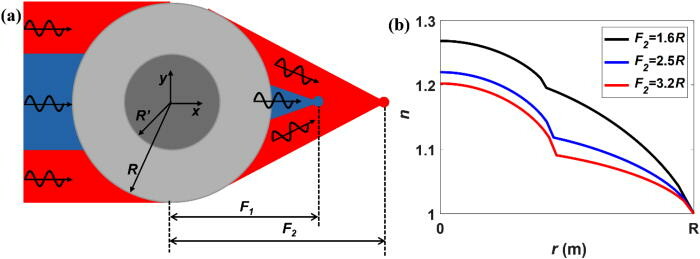 |

|
 |
The mechanism and design principle of the double-foci MGLL. The (a) schematic of the double-foci MGLL for manipulating acoustic waves and (b) distribution of the refractive index along the radial distance r for a different far-field focal length F2 (the near-field focal length F1 is fixed to be 1.2R) are shown. (Fig. 1 from the paper) |
|
ISR Postdoctoral Researcher Liuxian Zhao, Professor Miao Yu (ME/ISR), and ISR-affiliated Associate Professor Timothy Horiuchi (ECE) are continuing their Luneburg lens research with a new paper, Broadband ultra-long acoustic jet based on double-foci Luneburg lens. The research was recently published in Journal of the Acoustical Society of America Express Letters 1.
Recently developed acoustic metamaterials can control and manipulate acoustic wave propagation. These materials can be used to generate an acoustic jet, an acoustic focal field with a subwavelength full width at half maximum (FWHM) that is able to maintain a long propagation distance. These jets have potential applications in structural health monitoring, medical imaging, and energy harvesting.
In this paper, Zhao, Yu and Horiuchi propose a gradient index acoustic metamaterial based on the concept of the optical modified generalized Luneburg lens (MGLL). The Luneburg lens is a spherically symmetric gradient index (GRIN) lens, which can focus incoming plane waves onto the outer surface of the opposite side of the lens.
With an acoustic metamaterial MGLL, double-foci and high energy density between them can be achieved. This enables the realization of an ultra-long acoustic jet between the two foci. The paper demonstrates this capability of the MGLL theoretically and numerically with an acoustic metamaterial lens. Based on this design, ultra-long acoustic jets with a jet length of up to 30 k can be achieved, covering both the near field and far field.
Related Articles:
Adjustable Drug Release Marks New Milestone in Ingestible Capsule Research
Miao Yu to develop cost-effective sensor for measuring lake health
MSAL’s work on serotonin characterization and detection results in two journal covers
Abshire, Ernst receive MPower seed grant for using AI in understanding chronic pain biomarkers
Alum Timir Datta-Chaudhuri develops VNS biosensor for mice
Biofilm-fighting catheter insert research named 'featured article' in IEEE TBME
Biofilm-fighting system for urinary catheters proves effective in simulated environment
ACS presentation on 'smart marbles' featured on BioSpace website
Rapidly evolving ‘smart marble’ sensors hold promise for monitoring pharmaceutical industry bioreactors and beyond
Ingestible device research advances, enters new phase
November 8, 2021
|

